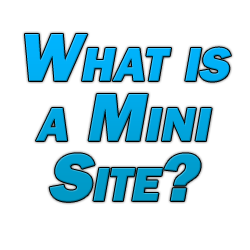Mini sites can generate high percentage conversion rates, but don’t always rank well. We cover exactly what is a mini site and how to use it today.
What is a Mini Site?
 A mini site is typically a one page website which revolves around some kind of direct response marketing (see what is direct response marketing) offer. This is in contrast to a content site which is made up of dozens, hundreds, or even thousands of pages of content. While the focus is entirely on the main page/offer, today mini sites oftentimes will have a few additional Google fluff pages to satisfy the search engines and give the implication of more quality.
A mini site is typically a one page website which revolves around some kind of direct response marketing (see what is direct response marketing) offer. This is in contrast to a content site which is made up of dozens, hundreds, or even thousands of pages of content. While the focus is entirely on the main page/offer, today mini sites oftentimes will have a few additional Google fluff pages to satisfy the search engines and give the implication of more quality.
Mini sites have been around practically as long as the internet has been. The first users of it were looking to bring their offline direct response marketing tactics online, and the mini site was born.
Mini sites are used to sell and elicit all kinds of responses from their visitors whether that’s selling a physical or digital product or getting some kind of personal information from the visitor such as an email address or the make of their car.
Some trademarks of the mini site:
- An eye grabbing headline
- Addresses the reader’s problem
- Provides a solution to the reader’s problem
- Offers social proof, testimonials, money back guarantee
- Images related to the product for sale
- A video to immediately catch the visitor’s attention
- A strong call to action to motivate the reader to take action
It can exist as a sales page, a single page review or blog site, or it can also be used as part of a sales funnel where someone would make a purchase from an initial mini site, then they could get hit with a second mini site afterwards to try to elicit a second sale of another related product.
The bottom line is that mini sites are straightforward, short, and to the point. There is no confusion about the focus of the site or the action which is required from the visitor or what they’ll get in return in full. This is why they convert so well and are so popular amongst affiliate and internet marketers in various niches – they exist solely to convert while limiting the typical distractions and other factors which stifle conversions.
